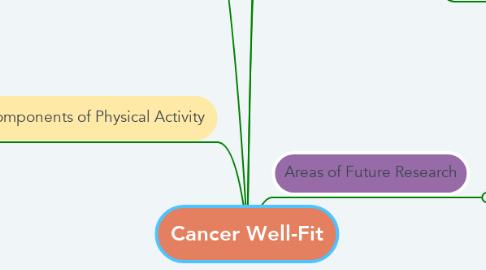Cancer Well-Fit
by Leslie Leeann Lingo


1. Components of Physical Activity
1.1. Cardiovascular exercise, resistance exercise, training, and flexibility
1.1.1. Noble 2011
1.2. Quality of life, fatigue level, ROM, and pain
1.2.1. Hwang 2008
1.3. Inpatient and home-based palliative care
1.3.1. Peters, Sellick 2006
1.4. Central Sensitization, peripheral sensitization, sympathetically maintained pain, nociceptive and cognitive affective therapy
1.4.1. Kumar 2011
1.5. ROM, aerobic exercise, strengthening and stretching upper limbs
1.5.1. Coughlin 2019
2. Issues in Research
2.1. Beginning poor health of patients receiving PT
2.1.1. Stromgen 2002
2.2. Withdraw from research due to death or can not longer perform physical activity due to cancer
2.2.1. Noble 2011, Rogers 2005
2.3. Home-based palliative care is typically only available to those that don't live alone
2.3.1. Peters, Sellick 2006
2.4. Older cancer patients are underrepresented
2.4.1. Mikkelsen 2018
2.5. Health care providers do not always give timely information about rehabilitation therapy to relieve symptoms
2.5.1. Lin 2012
2.6. Older cancer patients have higher incidence of limitations in physical therapy, a reduced QOL, and a higher prevalence of geriatric syndromes
2.6.1. Mikkelsen 2018
3. Areas of Future Research
3.1. Consider adjusting for age in breast cancer patient's efficacy and determining if additional adjustment for comorbidities is appropriate
3.1.1. Rogers 2005
3.2. Investigate PACE-Mobil-PBL effect among older patients with various malignancies to map out effects, common features, and differences among cancers
3.2.1. Mikkelsen 2018
3.3. Investigate other outcomes of home-based physical therapy including quality of life, bone mineral density, cognitive functioning, and chemo-induced peripheral neuropathy
3.3.1. Coughlin 2019
3.4. More longitudinal cohort studies rather than cross-sectional
3.4.1. Lin 2012
4. Efficacy of Patients
4.1. Patient responses to "unlivable, awful, to eliminate, etc" before and after PT
4.1.1. Tamburini 1991
4.2. Cancer related fatigue is more distressing than pain, nausea, and vomiting
4.2.1. Brown 2011
4.3. Study of level of self-efficacy, associations between barrier and task self-efficacy, and associations between self-efficacy and patient age, race, and treatment type
4.3.1. Rogers 2005
5. Results of PT in Various Cancers
5.1. Increase in feasibility and decrease in symptomatology
5.1.1. Stromgen 2002
5.2. Increase in self-efficacy
5.2.1. Rogers 2005, Brown 2011
5.3. Home-based physical therapy has positive effects on physical functioning and symptom management
5.3.1. Coughlin 2019
5.4. Moderate-intensity exercise therapy improved physical and psychological aspects in breast cancer patients receiving radiotherapy
5.4.1. Hwang 2007
5.5. Pt can prevent or reduce muscle weakness, declines in cardiovascular function, functional ability, and QOL
5.5.1. Coughlin 2019
